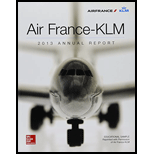
Concept explainers
1
Contingent liability is one form of liability that arises based on a particular outcome of a specific event. They are possible obligation that might arise or might not arise based on the future events. It is otherwise called as probable liability or eventual liability. Following are examples of contingencies:
- Income tax disputes
- Discounted notes receivable
- Lawsuits
- Debt guarantees
- Failure to follow government regulations
To measure: Contingent liability through traditional approach.
1
Explanation of Solution
As per traditional approach, H accrues more likely amount and it does not exceed probability of 50%. Here, at the end of the year 2019, Company H records loss and contingent liability amounting to $30 million based on probability of 50%.
2
To calculate: The amount H’s liability at end of the year 2016 fiscal year by applying the expected
2
Answer to Problem 13.8P
Explanation of Solution
Explanation
H’s liability (and loss) at the end of 2016 is determined by multiplying loss amount and probability with present value factor. The Present value of an ordinary annuity of $1 for 1 period at 5% is 0.95238 and refer Table 4 in Appendix).
3
To prepare:
3
Explanation of Solution
| Date | Accounts and Explanation | Post Ref | Debit ($) | Credit ($) | |||
| 2016 | Loss (E–) | 27,619,020 | |||||
| December | 31 | ||||||
| Estimated liability (L+) | 27,619,020 | ||||||
| (To record contingent liabilities) | |||||||
In order to record the contingent liabilities, Loss and estimated liability accounts are affected. Loss decreases the value of equity, and thus debit, loss account by $27,619,020. Estimated liability increases the liability account. Thus, credit estimated liability account by $27,619,020.
4
To Prepare: Journal entry to accrue interest on the liability at the end of 2017.
4
Explanation of Solution
| Date | Accounts and Explanation | Post Ref | Debit ($) | Credit ($) | |||
| 2017 | Interest Expense (E–) | 1,380,980 | |||||
| December | 31 | ||||||
| Estimated liability (L+) | 1,380,980 | ||||||
| (To record contingent liabilities) | |||||||
In order to record the contingent liabilities, Interest expense and estimated liability accounts are affected. Interest expense decreases the value of equity and thus, debit Interest expense account by $1,380,980. Estimated liability increases the liability account. Thus, credit estimated liability account by $1,380,980. Working note for determining amount of interest expense is as follows:
5
To prepare: Journal entry to pay the liability at the end of 2017.
5
Explanation of Solution
| Date | Accounts and Explanation | Post Ref | Debit ($) | Credit ($) | |||
| 2017 | Liability (L–) | 29,000,000 | |||||
| December | 31 | ||||||
| Loss (E–) | 2,000,000 | ||||||
| Cash (A–) | 31,000,000 | ||||||
| (To record contingent liabilities) | |||||||
When contingent liability is recorded, liability is decreased and thus, debits liability account by $29,000,000. Loss decreases the value of equity and thus, debits loss account by $2,000,000. Cash is an asset account and it decreases by $31,000,000. Thus, credit Cash account with $31,000,000.
Working notes below to determine the amount of loss is as below:
Want to see more full solutions like this?
Chapter 13 Solutions
LooseLeaf Intermediate Accounting w/ Annual Report; Connect Access Card
- What is the amount of current liabilities the firm has?arrow_forwardNeed answer of this question with financial accountingarrow_forwardThompson Aggrotech has a return on equity of 14.85 percent, a debt-equity ratio of 0.65, and a total asset turnover of 1.1. What is the return on assets?arrow_forward

 AccountingAccountingISBN:9781337272094Author:WARREN, Carl S., Reeve, James M., Duchac, Jonathan E.Publisher:Cengage Learning,
AccountingAccountingISBN:9781337272094Author:WARREN, Carl S., Reeve, James M., Duchac, Jonathan E.Publisher:Cengage Learning, Accounting Information SystemsAccountingISBN:9781337619202Author:Hall, James A.Publisher:Cengage Learning,
Accounting Information SystemsAccountingISBN:9781337619202Author:Hall, James A.Publisher:Cengage Learning, Horngren's Cost Accounting: A Managerial Emphasis...AccountingISBN:9780134475585Author:Srikant M. Datar, Madhav V. RajanPublisher:PEARSON
Horngren's Cost Accounting: A Managerial Emphasis...AccountingISBN:9780134475585Author:Srikant M. Datar, Madhav V. RajanPublisher:PEARSON Intermediate AccountingAccountingISBN:9781259722660Author:J. David Spiceland, Mark W. Nelson, Wayne M ThomasPublisher:McGraw-Hill Education
Intermediate AccountingAccountingISBN:9781259722660Author:J. David Spiceland, Mark W. Nelson, Wayne M ThomasPublisher:McGraw-Hill Education Financial and Managerial AccountingAccountingISBN:9781259726705Author:John J Wild, Ken W. Shaw, Barbara Chiappetta Fundamental Accounting PrinciplesPublisher:McGraw-Hill Education
Financial and Managerial AccountingAccountingISBN:9781259726705Author:John J Wild, Ken W. Shaw, Barbara Chiappetta Fundamental Accounting PrinciplesPublisher:McGraw-Hill Education





